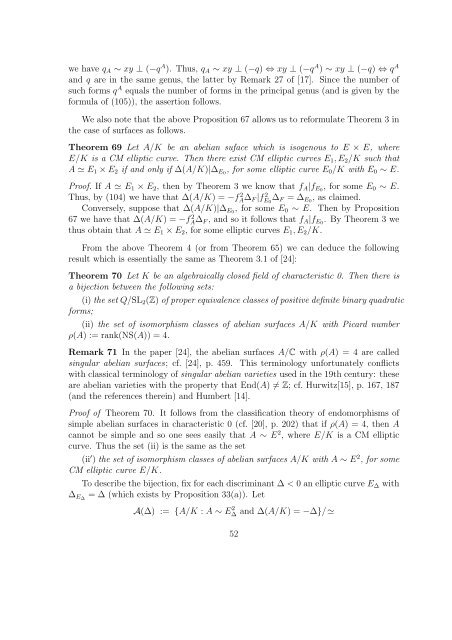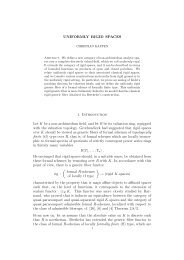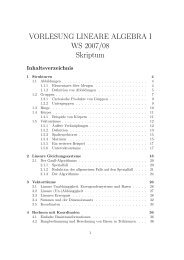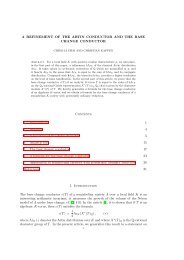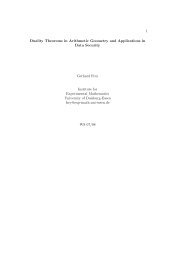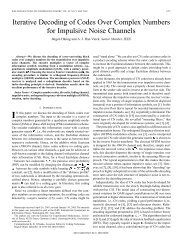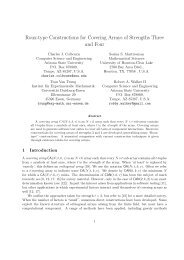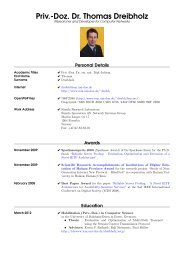Products of CM elliptic curves - Universität Duisburg-Essen
Products of CM elliptic curves - Universität Duisburg-Essen
Products of CM elliptic curves - Universität Duisburg-Essen
You also want an ePaper? Increase the reach of your titles
YUMPU automatically turns print PDFs into web optimized ePapers that Google loves.
we have q A ∼ xy ⊥ (−q A ). Thus, q A ∼ xy ⊥ (−q) ⇔ xy ⊥ (−q A ) ∼ xy ⊥ (−q) ⇔ q Aand q are in the same genus, the latter by Remark 27 <strong>of</strong> [17]. Since the number <strong>of</strong>such forms q A equals the number <strong>of</strong> forms in the principal genus (and is given by theformula <strong>of</strong> (105)), the assertion follows.We also note that the above Proposition 67 allows us to reformulate Theorem 3 inthe case <strong>of</strong> surfaces as follows.Theorem 69 Let A/K be an abelian suface which is isogenous to E × E, whereE/K is a <strong>CM</strong> <strong>elliptic</strong> curve. Then there exist <strong>CM</strong> <strong>elliptic</strong> <strong>curves</strong> E 1 , E 2 /K such thatA ≃ E 1 × E 2 if and only if ∆(A/K)|∆ E0 , for some <strong>elliptic</strong> curve E 0 /K with E 0 ∼ E.Pro<strong>of</strong>. If A ≃ E 1 × E 2 , then by Theorem 3 we know that f A |f E0 , for some E 0 ∼ E.Thus, by (104) we have that ∆(A/K) = −f 2 A ∆ F |f 2 E 0∆ F = ∆ E0 , as claimed.Conversely, suppose that ∆(A/K)|∆ E0 , for some E 0 ∼ E. Then by Proposition67 we have that ∆(A/K) = −f 2 A ∆ F , and so it follows that f A |f E0 . By Theorem 3 wethus obtain that A ≃ E 1 × E 2 , for some <strong>elliptic</strong> <strong>curves</strong> E 1 , E 2 /K.From the above Theorem 4 (or from Theorem 65) we can deduce the followingresult which is essentially the same as Theorem 3.1 <strong>of</strong> [24]:Theorem 70 Let K be an algebraically closed field <strong>of</strong> characteristic 0. Then there isa bijection between the following sets:(i) the set Q/SL 2 (Z) <strong>of</strong> proper equivalence classes <strong>of</strong> positive definite binary quadraticforms;(ii) the set <strong>of</strong> isomorphism classes <strong>of</strong> abelian surfaces A/K with Picard numberρ(A) := rank(NS(A)) = 4.Remark 71 In the paper [24], the abelian surfaces A/C with ρ(A) = 4 are calledsingular abelian surfaces; cf. [24], p. 459. This terminology unfortunately conflictswith classical terminology <strong>of</strong> singular abelian varieties used in the 19th century: theseare abelian varieties with the property that End(A) ≠ Z; cf. Hurwitz[15], p. 167, 187(and the references therein) and Humbert [14].Pro<strong>of</strong> <strong>of</strong> Theorem 70. It follows from the classification theory <strong>of</strong> endomorphisms <strong>of</strong>simple abelian surfaces in characteristic 0 (cf. [20], p. 202) that if ρ(A) = 4, then Acannot be simple and so one sees easily that A ∼ E 2 , where E/K is a <strong>CM</strong> <strong>elliptic</strong>curve. Thus the set (ii) is the same as the set(ii ′ ) the set <strong>of</strong> isomorphism classes <strong>of</strong> abelian surfaces A/K with A ∼ E 2 , for some<strong>CM</strong> <strong>elliptic</strong> curve E/K.To describe the bijection, fix for each discriminant ∆ < 0 an <strong>elliptic</strong> curve E ∆ with∆ E∆ = ∆ (which exists by Proposition 33(a)). LetA(∆) := {A/K : A ∼ E 2 ∆ and ∆(A/K) = −∆}/≃52


